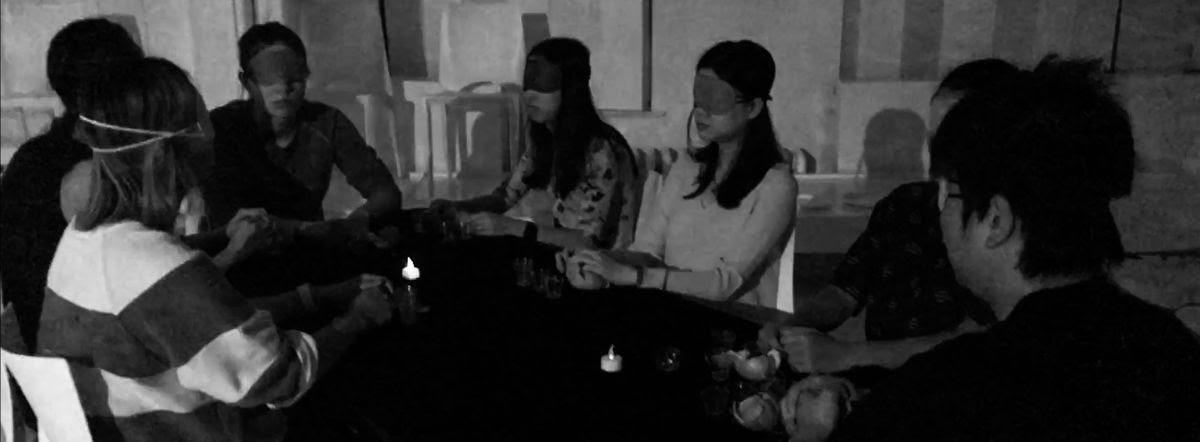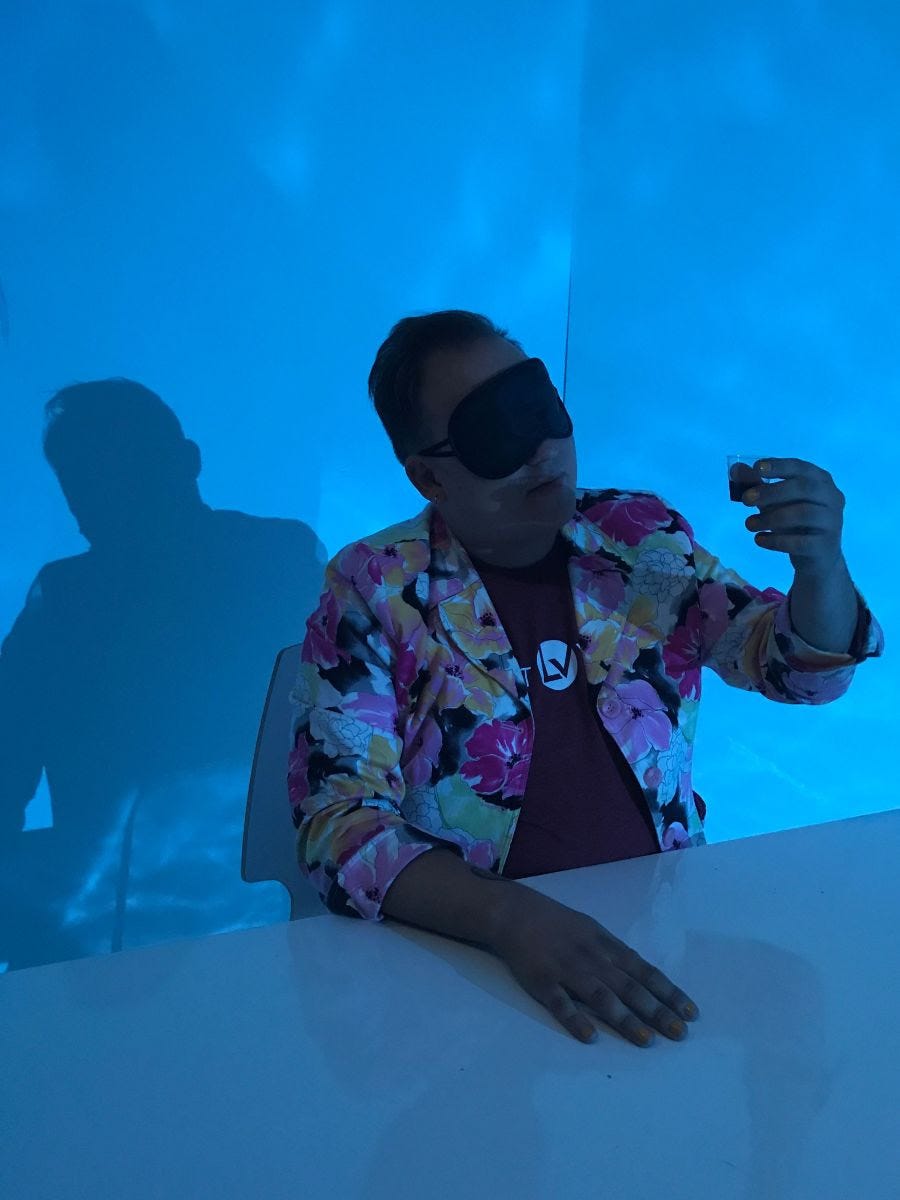
I feel velvet at my fingertips. I can sense there are others at the table with me. A soft ringing sound echoes around my head and a small round cup is placed into my hands to drink. The smell of jasmine is inescapable. I sip at the hot liquid. Its bitter taste is oddly satisfying given everything else that surrounds me. My senses are on overload. Yet the one I rely on most has been taken from me. I sit in the darkness and enjoy this moment.
Theatre in the Dark: Carpe Diem is the latest show from the aptly named This Is Not a Theatre Company. Having been instructed to wash our hands, each participant is handed a simple eye mask. We trust our hosts, and our fellow audience members, as we line up single file to walk into the space, masks in place. I put my hands on the shoulders of the woman in front of me, and ponder the phrase “the blind leading the blind” as we make our way into the performance space. A (presumably sighted) staff member gently guides me to a chair to begin the experience.
The entire premise of the piece is to focus on your other senses once sight is taken away from you. As would be expected, the other senses seem to rise to the challenge, with every sensation being raised to new heights. Over the course of ten scenes, we are exposed to various smells, tastes, sounds, and moments of poetry.

There are several scenes which will seem oddly familiar to those who’ve attended past productions from This Is Not a Theatre Company. In one scene, a bottle and a vase are having a deep philosophical discussion between themselves. In another, we are invited to choreograph the “dance of chocolate,” as we quietly divulge in a delicious piece of dark chocolate with a strange center. Other scenes (my use of “scene” being ironic, of course, due to there being no visuals) included: a riddle about a piece of fruit which we were invited to taste after the answer had become clear; the smells of lavender accompanying a love song; and one where we were handed a rock-like creation to taste. The candied ginger became particularly delicious once I realized it was not going to break my teeth; as we ate the candy, quiet poetry reverberated around the room.
But, there does not seem to be a thematic or other link between the poetry and the sensations that abound during Theatre in the Dark: Carpe Diem. Only in retrospect, alongside conversations with other patrons, did the theme of Death arise. The only clue I had previously was a reference ‘“ASMR Memento Mori,” which was totally lost on me mid-show. Perhaps it is because of the sensory overload that these themes were not so clear at the time. Each scene felt like its own miniature vignette, as opposed to a part of the overall piece. Perhaps a narrative linking the vignettes would have helped bring the audience along for the ride, as opposed to just enjoying each small sample on its own.
Get Edward Mylechreest’s stories in your inbox
Join Medium for free to get updates from this writer.
SubscribeSubscribe
Less successful is the inclusion of ASMR techniques. As someone who does not experience the sensation, but has enjoyed several ASMR-inducing performances, I admire the patience and craftsmanship of those who help to create the experience. In Theatre in the Dark: Carpe Diem, at seemingly random moments a voice would suddenly whisper in my ear. As calming as I am sure this was intended to be, it came across as something of a jump scare and actually became quite comical hearing my fellow tablemates exclaim upon being startled. Here this felt like a tagged-on addition to the experience, by a team who has heard that ASMR is a hip new thing to do, but who don’t really understand how it works. I could be wrong, and perhaps visuals are key to ASMR fulfillment given the proliferation of ASMR YouTube videos, but it may be that greater study is needed by the creative team and performers before attempting this unique and specific skill set.
Theatre in the Dark: Carpe Diem is by no means the first “dinner in the dark” experience in NYC, it is not the first immersive ASMR experience to be offered, and it is certainly not the first “in the dark” theatre experience to be created. Overall, I did enjoy Theatre in the Dark: Carpe Diem, but I was left with something of an empty feeling once the evening had concluded somewhat awkwardly, as the lights came on and we were told, the show had finished.
What was this piece trying to do? What was it trying to say? What areas of immersive was it trying to push forward?
Being seated in the dark, with a group of apparent strangers, there is so much potential for great immersive content. Play with our senses further, lead us to make assumptions about what we are tasting or hearing. Subvert them. Ask us deep questions, make us question ourselves. These are the things that the best immersive theatre pieces do. Instead, everything here felt safe, comfortable, and relatively straightforward. The food was lovely, the ambiance intriguing, and the experience entertaining. It was a nice “taste test” of immersive theatre, with small samples for the audience to enjoy. Perhaps if you have never experienced immersive theatre before these immersive snippets will have been enough.
Just I would have liked something a little more filling.
Theatre in the Dark: Carpe Diem continues in New York City through October 6. Tickets are $25–30.
NoPro is a labor of love made possible by our generous Patreon backers. Join them today!
In addition to the No Proscenium web site, our podcast, and our newsletters, you can find NoPro on Twitter, Facebook, YouTube, Instagram, in the Facebook community Everything Immersive, and on our Slack forum.
Office facilities provided by Thymele Arts, in Los Angeles, CA.




















Discussion